Design and Development of a Relational Database System Project
VerifiedAdded on 2024/04/26
|49
|6097
|126
Project
AI Summary
This project outlines the design and development of a relational database system for an art gallery, addressing user and system requirements through logical, physical, and conceptual designs. The database, built using MS Access, incorporates data normalization to enhance scalability and integrity. Key aspects include ER diagrams illustrating entity relationships, data validation techniques for ensuring data accuracy, and the implementation of SQL queries for data retrieval. The project also covers comprehensive system testing against defined requirements using white box and black box testing methods, alongside detailed technical and user documentation to facilitate understanding and usability of the database system. The database structure encompasses tables for art bookings, art groups, artists, art staff, artwork, customers, upcoming exhibitions, and gallery branches, demonstrating a full functional implementation with user interfaces and data validations.
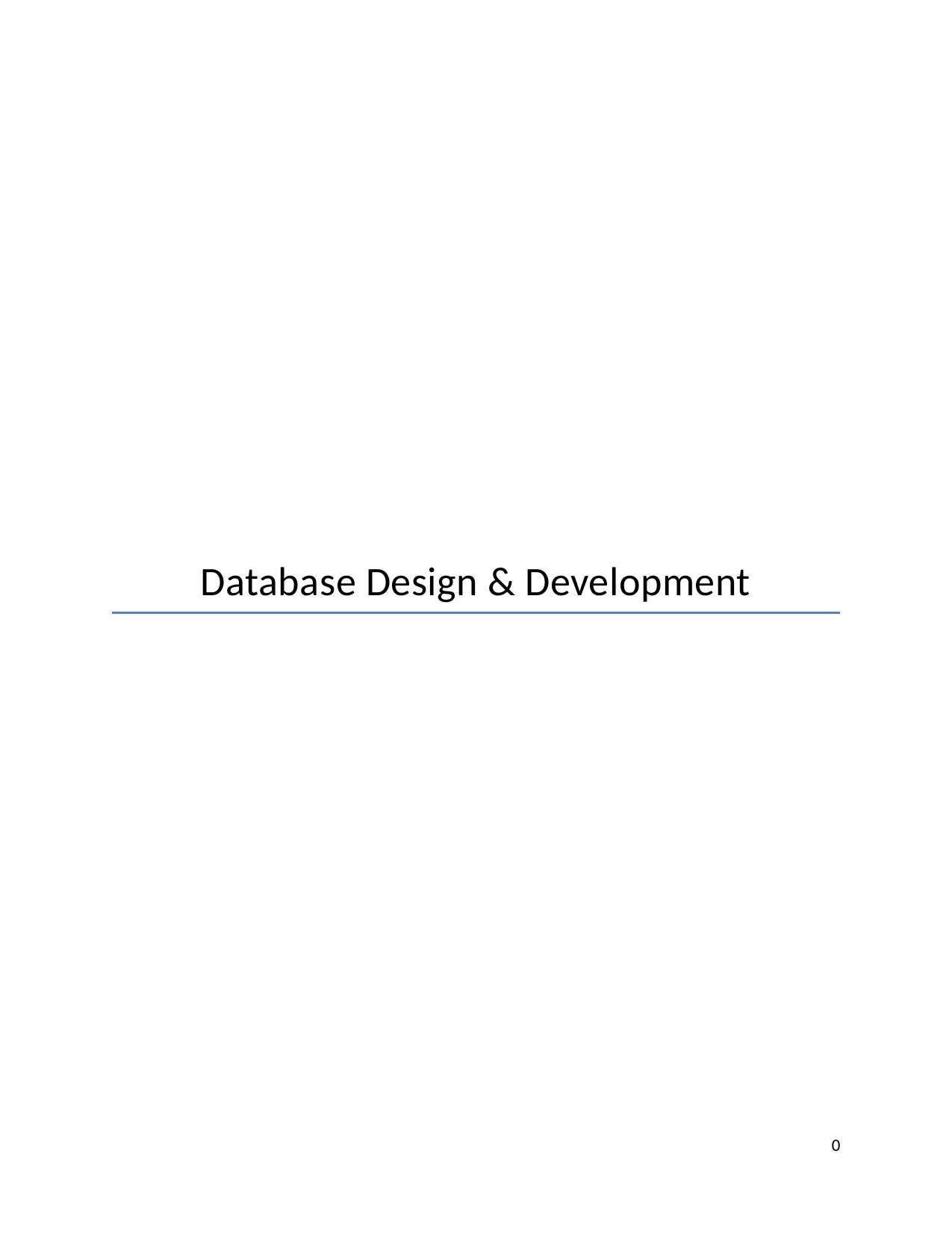
Database Design & Development
0
0
Paraphrase This Document
Need a fresh take? Get an instant paraphrase of this document with our AI Paraphraser
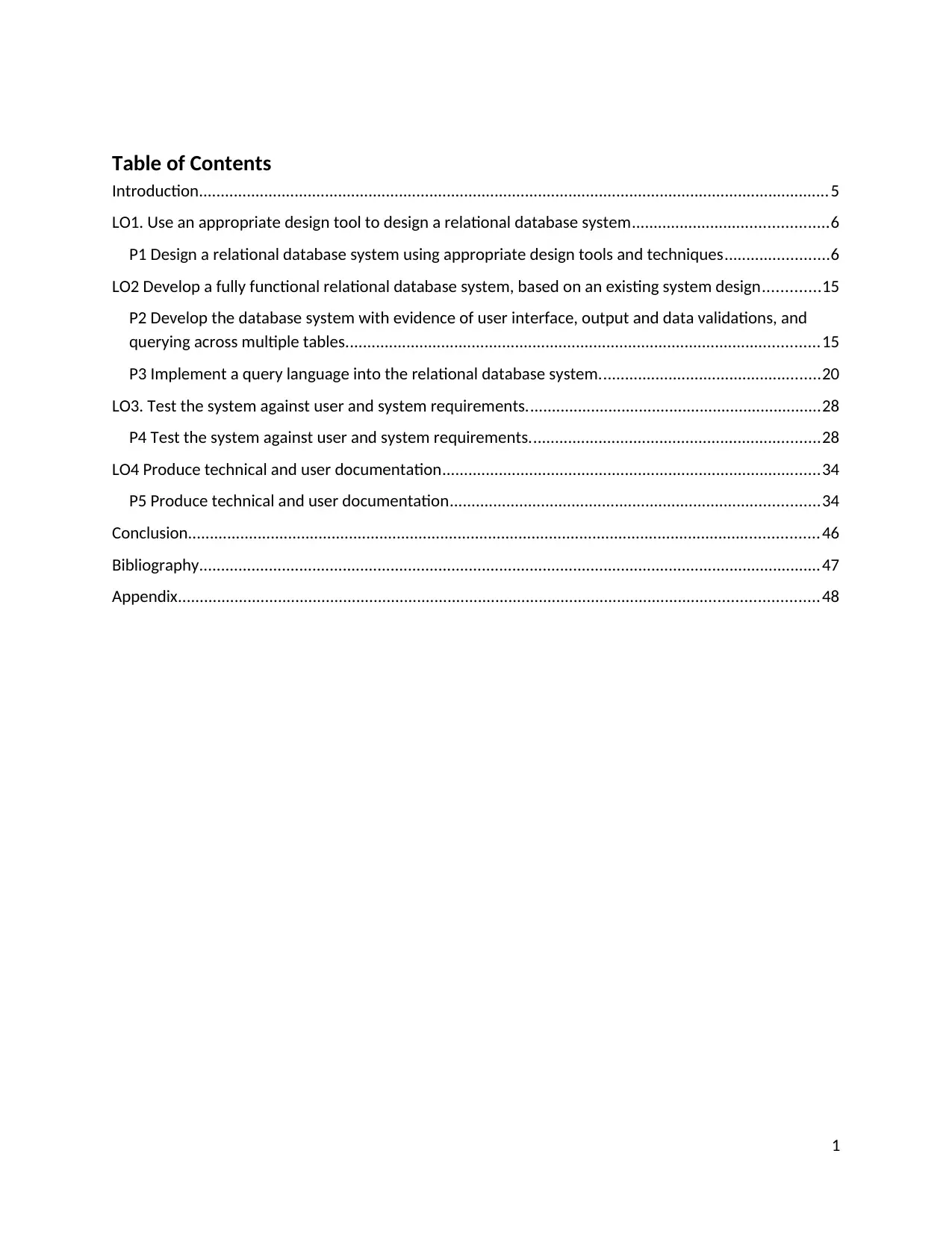
Table of Contents
Introduction.................................................................................................................................................5
LO1. Use an appropriate design tool to design a relational database system.............................................6
P1 Design a relational database system using appropriate design tools and techniques........................6
LO2 Develop a fully functional relational database system, based on an existing system design.............15
P2 Develop the database system with evidence of user interface, output and data validations, and
querying across multiple tables.............................................................................................................15
P3 Implement a query language into the relational database system...................................................20
LO3. Test the system against user and system requirements....................................................................28
P4 Test the system against user and system requirements...................................................................28
LO4 Produce technical and user documentation.......................................................................................34
P5 Produce technical and user documentation.....................................................................................34
Conclusion.................................................................................................................................................46
Bibliography...............................................................................................................................................47
Appendix...................................................................................................................................................48
1
Introduction.................................................................................................................................................5
LO1. Use an appropriate design tool to design a relational database system.............................................6
P1 Design a relational database system using appropriate design tools and techniques........................6
LO2 Develop a fully functional relational database system, based on an existing system design.............15
P2 Develop the database system with evidence of user interface, output and data validations, and
querying across multiple tables.............................................................................................................15
P3 Implement a query language into the relational database system...................................................20
LO3. Test the system against user and system requirements....................................................................28
P4 Test the system against user and system requirements...................................................................28
LO4 Produce technical and user documentation.......................................................................................34
P5 Produce technical and user documentation.....................................................................................34
Conclusion.................................................................................................................................................46
Bibliography...............................................................................................................................................47
Appendix...................................................................................................................................................48
1
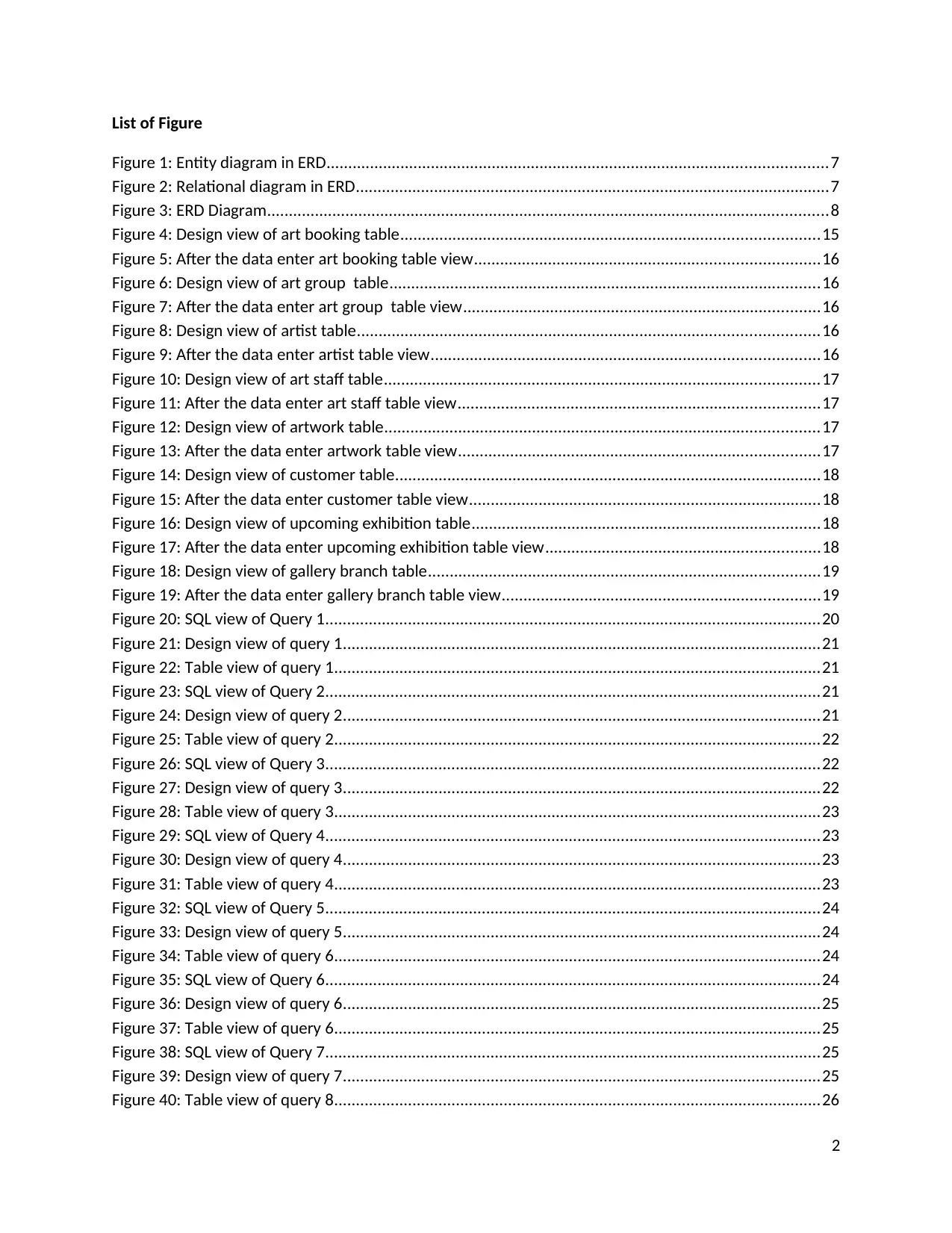
List of Figure
Figure 1: Entity diagram in ERD...................................................................................................................7
Figure 2: Relational diagram in ERD.............................................................................................................7
Figure 3: ERD Diagram.................................................................................................................................8
Figure 4: Design view of art booking table................................................................................................15
Figure 5: After the data enter art booking table view...............................................................................16
Figure 6: Design view of art group table...................................................................................................16
Figure 7: After the data enter art group table view..................................................................................16
Figure 8: Design view of artist table..........................................................................................................16
Figure 9: After the data enter artist table view.........................................................................................16
Figure 10: Design view of art staff table....................................................................................................17
Figure 11: After the data enter art staff table view...................................................................................17
Figure 12: Design view of artwork table....................................................................................................17
Figure 13: After the data enter artwork table view...................................................................................17
Figure 14: Design view of customer table..................................................................................................18
Figure 15: After the data enter customer table view.................................................................................18
Figure 16: Design view of upcoming exhibition table................................................................................18
Figure 17: After the data enter upcoming exhibition table view...............................................................18
Figure 18: Design view of gallery branch table..........................................................................................19
Figure 19: After the data enter gallery branch table view.........................................................................19
Figure 20: SQL view of Query 1..................................................................................................................20
Figure 21: Design view of query 1..............................................................................................................21
Figure 22: Table view of query 1................................................................................................................21
Figure 23: SQL view of Query 2..................................................................................................................21
Figure 24: Design view of query 2..............................................................................................................21
Figure 25: Table view of query 2................................................................................................................22
Figure 26: SQL view of Query 3..................................................................................................................22
Figure 27: Design view of query 3..............................................................................................................22
Figure 28: Table view of query 3................................................................................................................23
Figure 29: SQL view of Query 4..................................................................................................................23
Figure 30: Design view of query 4..............................................................................................................23
Figure 31: Table view of query 4................................................................................................................23
Figure 32: SQL view of Query 5..................................................................................................................24
Figure 33: Design view of query 5..............................................................................................................24
Figure 34: Table view of query 6................................................................................................................24
Figure 35: SQL view of Query 6..................................................................................................................24
Figure 36: Design view of query 6..............................................................................................................25
Figure 37: Table view of query 6................................................................................................................25
Figure 38: SQL view of Query 7..................................................................................................................25
Figure 39: Design view of query 7..............................................................................................................25
Figure 40: Table view of query 8................................................................................................................26
2
Figure 1: Entity diagram in ERD...................................................................................................................7
Figure 2: Relational diagram in ERD.............................................................................................................7
Figure 3: ERD Diagram.................................................................................................................................8
Figure 4: Design view of art booking table................................................................................................15
Figure 5: After the data enter art booking table view...............................................................................16
Figure 6: Design view of art group table...................................................................................................16
Figure 7: After the data enter art group table view..................................................................................16
Figure 8: Design view of artist table..........................................................................................................16
Figure 9: After the data enter artist table view.........................................................................................16
Figure 10: Design view of art staff table....................................................................................................17
Figure 11: After the data enter art staff table view...................................................................................17
Figure 12: Design view of artwork table....................................................................................................17
Figure 13: After the data enter artwork table view...................................................................................17
Figure 14: Design view of customer table..................................................................................................18
Figure 15: After the data enter customer table view.................................................................................18
Figure 16: Design view of upcoming exhibition table................................................................................18
Figure 17: After the data enter upcoming exhibition table view...............................................................18
Figure 18: Design view of gallery branch table..........................................................................................19
Figure 19: After the data enter gallery branch table view.........................................................................19
Figure 20: SQL view of Query 1..................................................................................................................20
Figure 21: Design view of query 1..............................................................................................................21
Figure 22: Table view of query 1................................................................................................................21
Figure 23: SQL view of Query 2..................................................................................................................21
Figure 24: Design view of query 2..............................................................................................................21
Figure 25: Table view of query 2................................................................................................................22
Figure 26: SQL view of Query 3..................................................................................................................22
Figure 27: Design view of query 3..............................................................................................................22
Figure 28: Table view of query 3................................................................................................................23
Figure 29: SQL view of Query 4..................................................................................................................23
Figure 30: Design view of query 4..............................................................................................................23
Figure 31: Table view of query 4................................................................................................................23
Figure 32: SQL view of Query 5..................................................................................................................24
Figure 33: Design view of query 5..............................................................................................................24
Figure 34: Table view of query 6................................................................................................................24
Figure 35: SQL view of Query 6..................................................................................................................24
Figure 36: Design view of query 6..............................................................................................................25
Figure 37: Table view of query 6................................................................................................................25
Figure 38: SQL view of Query 7..................................................................................................................25
Figure 39: Design view of query 7..............................................................................................................25
Figure 40: Table view of query 8................................................................................................................26
2
⊘ This is a preview!⊘
Do you want full access?
Subscribe today to unlock all pages.

Trusted by 1+ million students worldwide
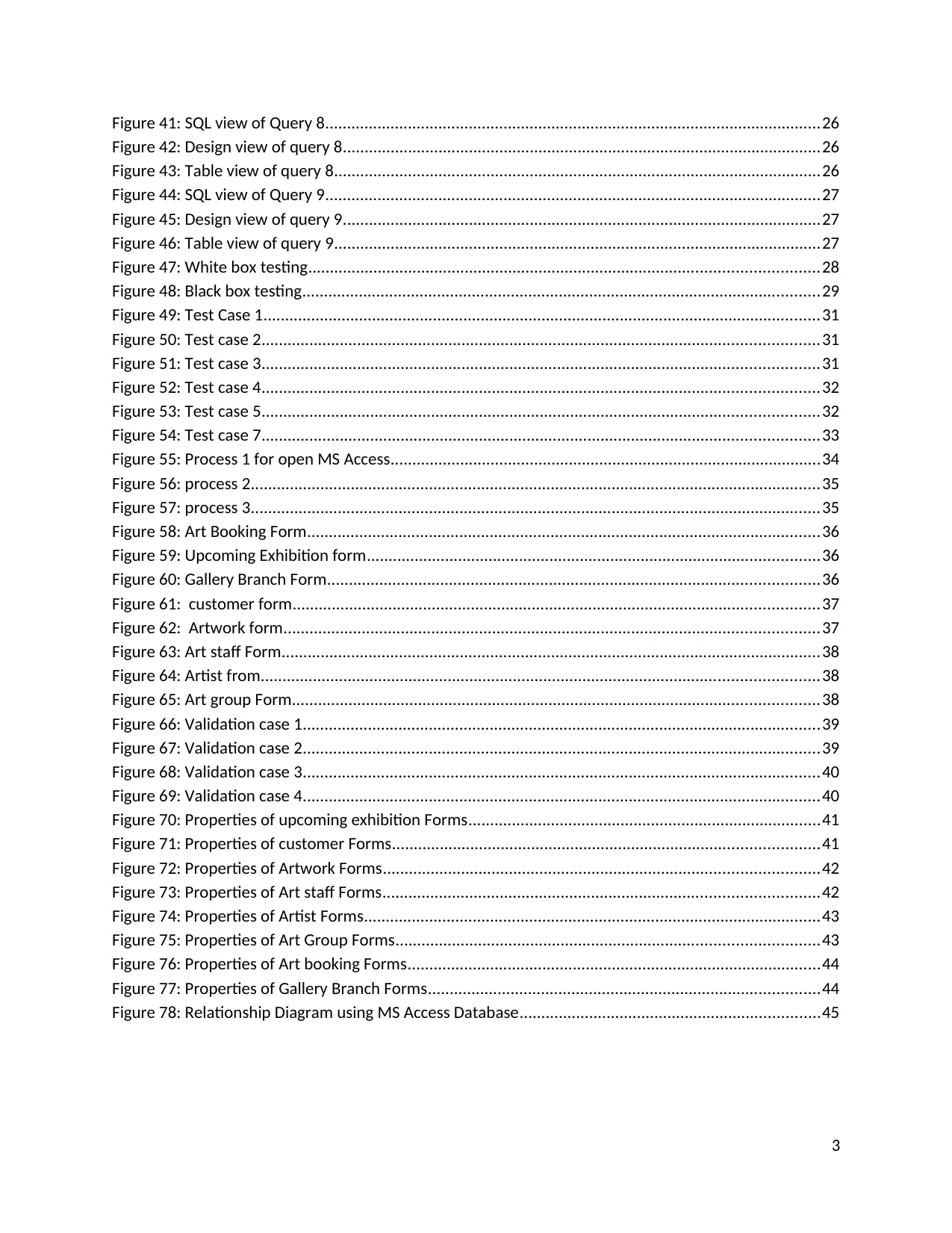
Figure 41: SQL view of Query 8..................................................................................................................26
Figure 42: Design view of query 8..............................................................................................................26
Figure 43: Table view of query 8................................................................................................................26
Figure 44: SQL view of Query 9..................................................................................................................27
Figure 45: Design view of query 9..............................................................................................................27
Figure 46: Table view of query 9................................................................................................................27
Figure 47: White box testing.....................................................................................................................28
Figure 48: Black box testing.......................................................................................................................29
Figure 49: Test Case 1................................................................................................................................31
Figure 50: Test case 2................................................................................................................................31
Figure 51: Test case 3................................................................................................................................31
Figure 52: Test case 4................................................................................................................................32
Figure 53: Test case 5................................................................................................................................32
Figure 54: Test case 7................................................................................................................................33
Figure 55: Process 1 for open MS Access...................................................................................................34
Figure 56: process 2...................................................................................................................................35
Figure 57: process 3...................................................................................................................................35
Figure 58: Art Booking Form......................................................................................................................36
Figure 59: Upcoming Exhibition form........................................................................................................36
Figure 60: Gallery Branch Form.................................................................................................................36
Figure 61: customer form.........................................................................................................................37
Figure 62: Artwork form...........................................................................................................................37
Figure 63: Art staff Form............................................................................................................................38
Figure 64: Artist from................................................................................................................................38
Figure 65: Art group Form.........................................................................................................................38
Figure 66: Validation case 1.......................................................................................................................39
Figure 67: Validation case 2.......................................................................................................................39
Figure 68: Validation case 3.......................................................................................................................40
Figure 69: Validation case 4.......................................................................................................................40
Figure 70: Properties of upcoming exhibition Forms.................................................................................41
Figure 71: Properties of customer Forms..................................................................................................41
Figure 72: Properties of Artwork Forms....................................................................................................42
Figure 73: Properties of Art staff Forms....................................................................................................42
Figure 74: Properties of Artist Forms.........................................................................................................43
Figure 75: Properties of Art Group Forms.................................................................................................43
Figure 76: Properties of Art booking Forms...............................................................................................44
Figure 77: Properties of Gallery Branch Forms..........................................................................................44
Figure 78: Relationship Diagram using MS Access Database.....................................................................45
3
Figure 42: Design view of query 8..............................................................................................................26
Figure 43: Table view of query 8................................................................................................................26
Figure 44: SQL view of Query 9..................................................................................................................27
Figure 45: Design view of query 9..............................................................................................................27
Figure 46: Table view of query 9................................................................................................................27
Figure 47: White box testing.....................................................................................................................28
Figure 48: Black box testing.......................................................................................................................29
Figure 49: Test Case 1................................................................................................................................31
Figure 50: Test case 2................................................................................................................................31
Figure 51: Test case 3................................................................................................................................31
Figure 52: Test case 4................................................................................................................................32
Figure 53: Test case 5................................................................................................................................32
Figure 54: Test case 7................................................................................................................................33
Figure 55: Process 1 for open MS Access...................................................................................................34
Figure 56: process 2...................................................................................................................................35
Figure 57: process 3...................................................................................................................................35
Figure 58: Art Booking Form......................................................................................................................36
Figure 59: Upcoming Exhibition form........................................................................................................36
Figure 60: Gallery Branch Form.................................................................................................................36
Figure 61: customer form.........................................................................................................................37
Figure 62: Artwork form...........................................................................................................................37
Figure 63: Art staff Form............................................................................................................................38
Figure 64: Artist from................................................................................................................................38
Figure 65: Art group Form.........................................................................................................................38
Figure 66: Validation case 1.......................................................................................................................39
Figure 67: Validation case 2.......................................................................................................................39
Figure 68: Validation case 3.......................................................................................................................40
Figure 69: Validation case 4.......................................................................................................................40
Figure 70: Properties of upcoming exhibition Forms.................................................................................41
Figure 71: Properties of customer Forms..................................................................................................41
Figure 72: Properties of Artwork Forms....................................................................................................42
Figure 73: Properties of Art staff Forms....................................................................................................42
Figure 74: Properties of Artist Forms.........................................................................................................43
Figure 75: Properties of Art Group Forms.................................................................................................43
Figure 76: Properties of Art booking Forms...............................................................................................44
Figure 77: Properties of Gallery Branch Forms..........................................................................................44
Figure 78: Relationship Diagram using MS Access Database.....................................................................45
3
Paraphrase This Document
Need a fresh take? Get an instant paraphrase of this document with our AI Paraphraser
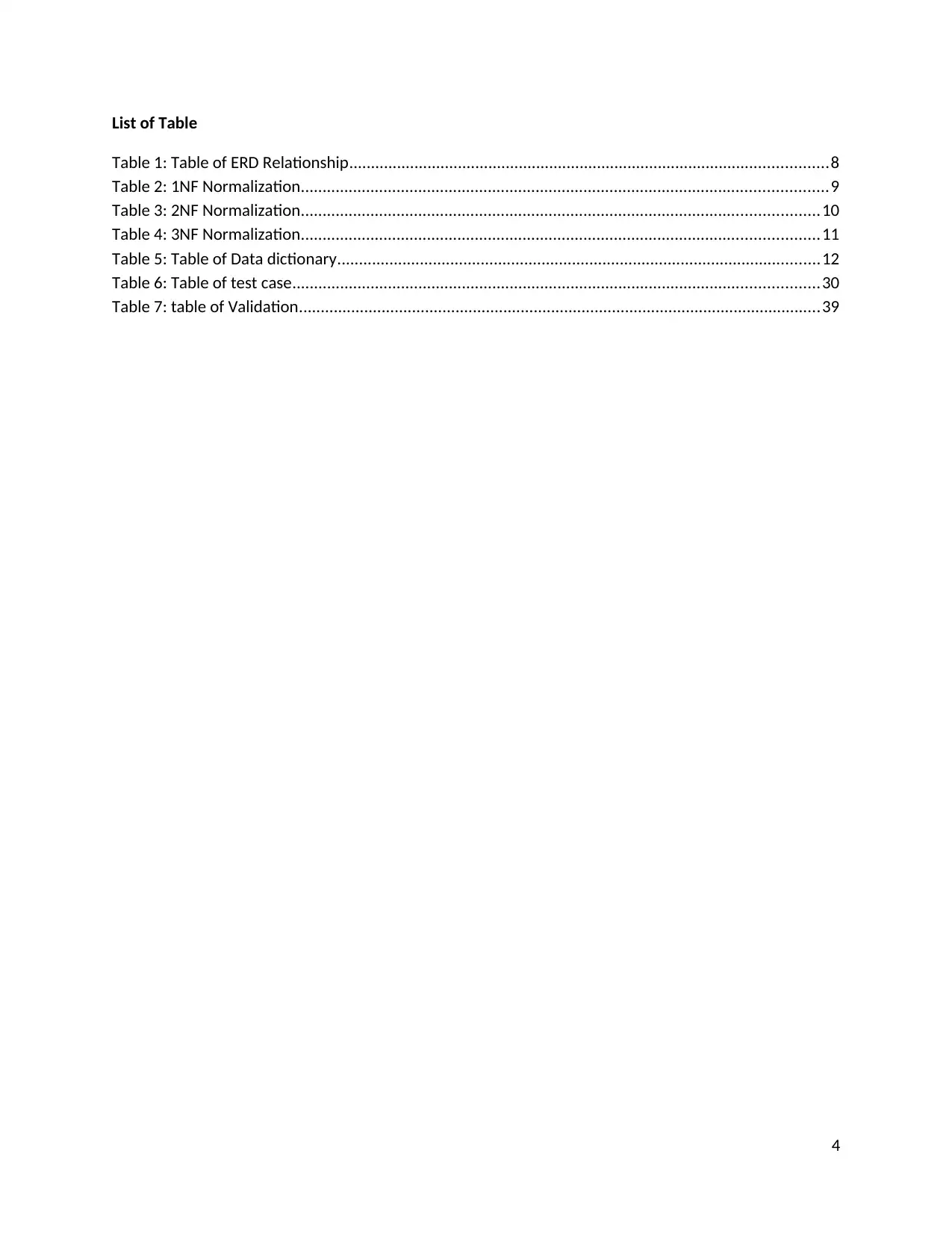
List of Table
Table 1: Table of ERD Relationship..............................................................................................................8
Table 2: 1NF Normalization.........................................................................................................................9
Table 3: 2NF Normalization.......................................................................................................................10
Table 4: 3NF Normalization.......................................................................................................................11
Table 5: Table of Data dictionary...............................................................................................................12
Table 6: Table of test case.........................................................................................................................30
Table 7: table of Validation........................................................................................................................39
4
Table 1: Table of ERD Relationship..............................................................................................................8
Table 2: 1NF Normalization.........................................................................................................................9
Table 3: 2NF Normalization.......................................................................................................................10
Table 4: 3NF Normalization.......................................................................................................................11
Table 5: Table of Data dictionary...............................................................................................................12
Table 6: Table of test case.........................................................................................................................30
Table 7: table of Validation........................................................................................................................39
4
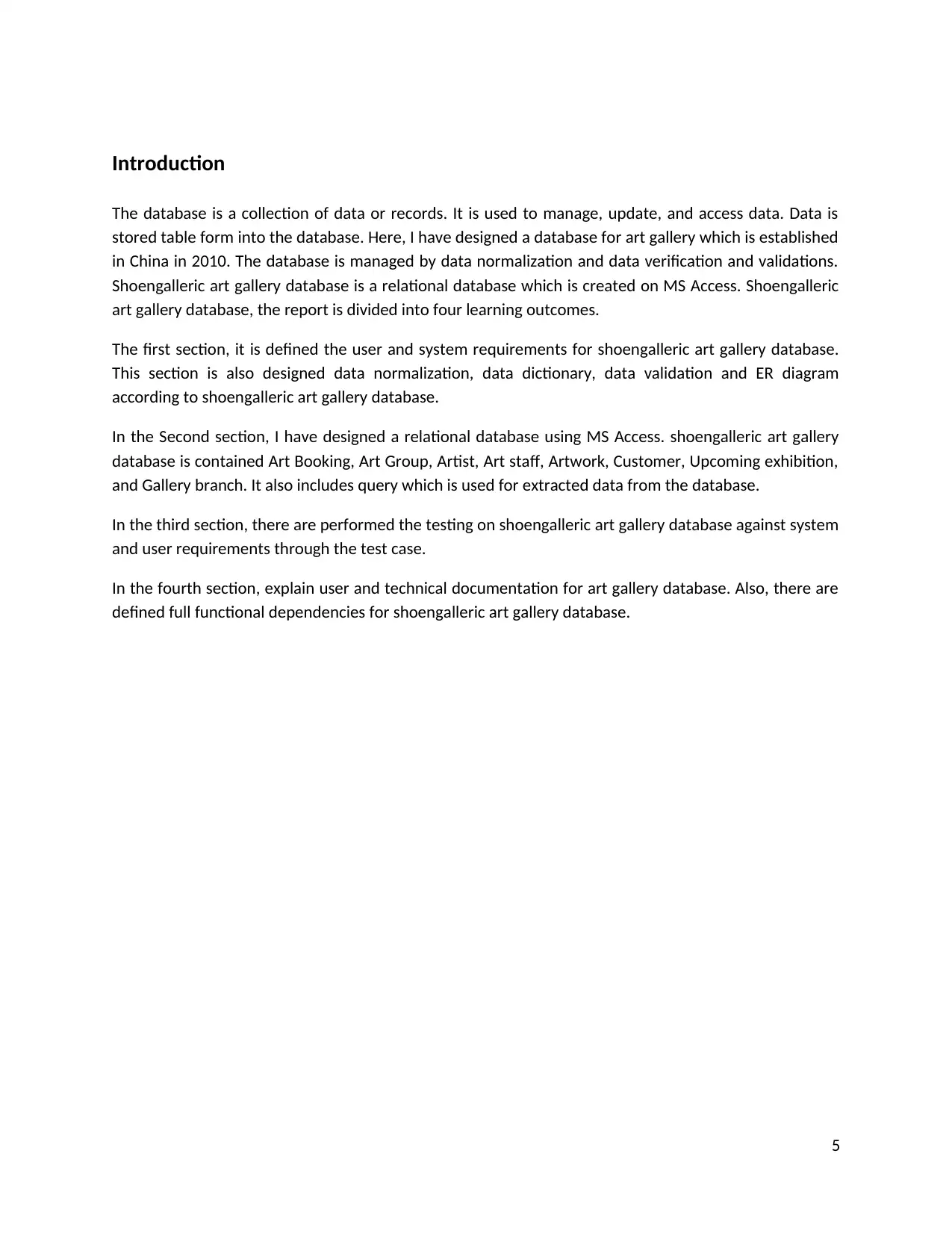
Introduction
The database is a collection of data or records. It is used to manage, update, and access data. Data is
stored table form into the database. Here, I have designed a database for art gallery which is established
in China in 2010. The database is managed by data normalization and data verification and validations.
Shoengalleric art gallery database is a relational database which is created on MS Access. Shoengalleric
art gallery database, the report is divided into four learning outcomes.
The first section, it is defined the user and system requirements for shoengalleric art gallery database.
This section is also designed data normalization, data dictionary, data validation and ER diagram
according to shoengalleric art gallery database.
In the Second section, I have designed a relational database using MS Access. shoengalleric art gallery
database is contained Art Booking, Art Group, Artist, Art staff, Artwork, Customer, Upcoming exhibition,
and Gallery branch. It also includes query which is used for extracted data from the database.
In the third section, there are performed the testing on shoengalleric art gallery database against system
and user requirements through the test case.
In the fourth section, explain user and technical documentation for art gallery database. Also, there are
defined full functional dependencies for shoengalleric art gallery database.
5
The database is a collection of data or records. It is used to manage, update, and access data. Data is
stored table form into the database. Here, I have designed a database for art gallery which is established
in China in 2010. The database is managed by data normalization and data verification and validations.
Shoengalleric art gallery database is a relational database which is created on MS Access. Shoengalleric
art gallery database, the report is divided into four learning outcomes.
The first section, it is defined the user and system requirements for shoengalleric art gallery database.
This section is also designed data normalization, data dictionary, data validation and ER diagram
according to shoengalleric art gallery database.
In the Second section, I have designed a relational database using MS Access. shoengalleric art gallery
database is contained Art Booking, Art Group, Artist, Art staff, Artwork, Customer, Upcoming exhibition,
and Gallery branch. It also includes query which is used for extracted data from the database.
In the third section, there are performed the testing on shoengalleric art gallery database against system
and user requirements through the test case.
In the fourth section, explain user and technical documentation for art gallery database. Also, there are
defined full functional dependencies for shoengalleric art gallery database.
5
⊘ This is a preview!⊘
Do you want full access?
Subscribe today to unlock all pages.

Trusted by 1+ million students worldwide
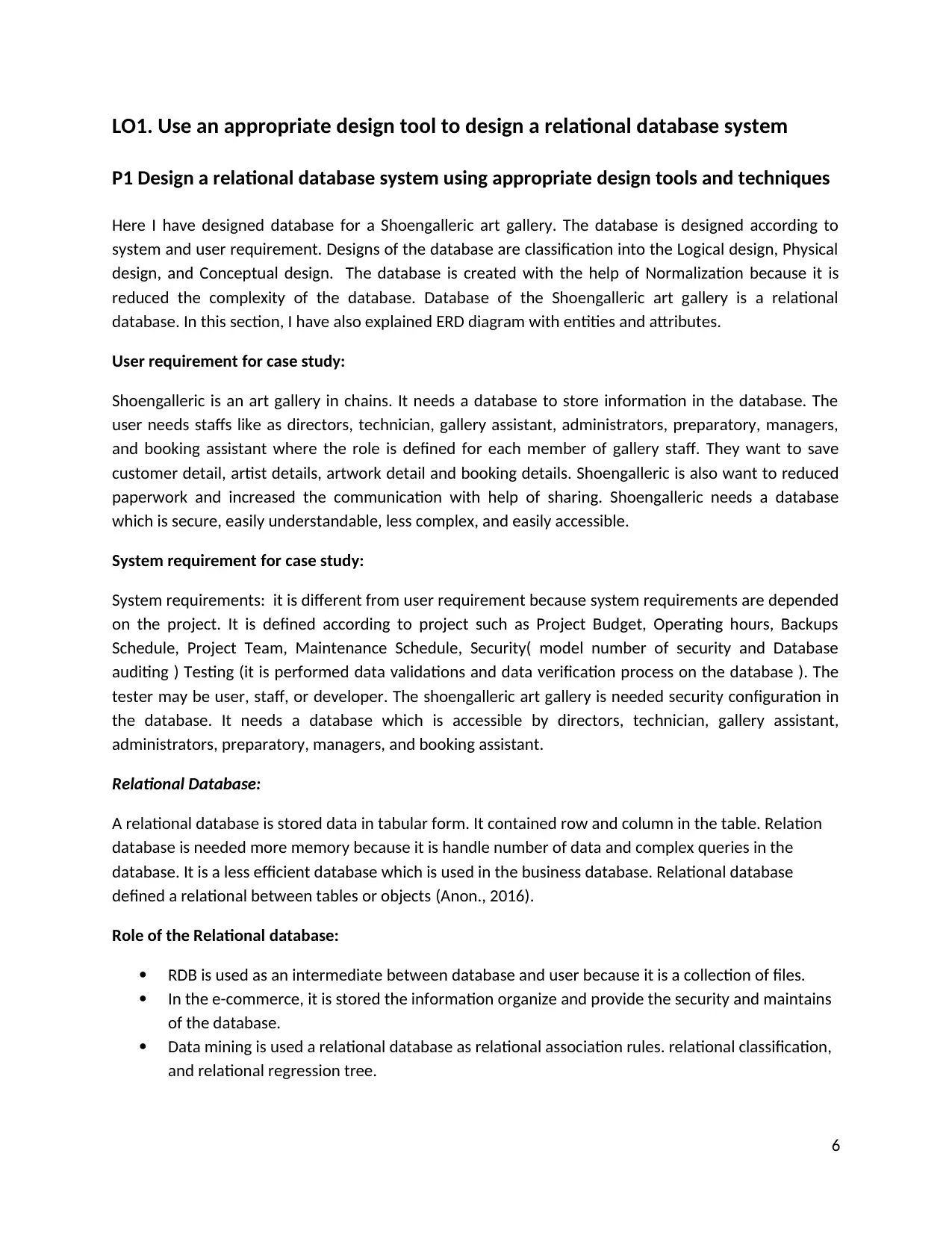
LO1. Use an appropriate design tool to design a relational database system
P1 Design a relational database system using appropriate design tools and techniques
Here I have designed database for a Shoengalleric art gallery. The database is designed according to
system and user requirement. Designs of the database are classification into the Logical design, Physical
design, and Conceptual design. The database is created with the help of Normalization because it is
reduced the complexity of the database. Database of the Shoengalleric art gallery is a relational
database. In this section, I have also explained ERD diagram with entities and attributes.
User requirement for case study:
Shoengalleric is an art gallery in chains. It needs a database to store information in the database. The
user needs staffs like as directors, technician, gallery assistant, administrators, preparatory, managers,
and booking assistant where the role is defined for each member of gallery staff. They want to save
customer detail, artist details, artwork detail and booking details. Shoengalleric is also want to reduced
paperwork and increased the communication with help of sharing. Shoengalleric needs a database
which is secure, easily understandable, less complex, and easily accessible.
System requirement for case study:
System requirements: it is different from user requirement because system requirements are depended
on the project. It is defined according to project such as Project Budget, Operating hours, Backups
Schedule, Project Team, Maintenance Schedule, Security( model number of security and Database
auditing ) Testing (it is performed data validations and data verification process on the database ). The
tester may be user, staff, or developer. The shoengalleric art gallery is needed security configuration in
the database. It needs a database which is accessible by directors, technician, gallery assistant,
administrators, preparatory, managers, and booking assistant.
Relational Database:
A relational database is stored data in tabular form. It contained row and column in the table. Relation
database is needed more memory because it is handle number of data and complex queries in the
database. It is a less efficient database which is used in the business database. Relational database
defined a relational between tables or objects (Anon., 2016).
Role of the Relational database:
RDB is used as an intermediate between database and user because it is a collection of files.
In the e-commerce, it is stored the information organize and provide the security and maintains
of the database.
Data mining is used a relational database as relational association rules. relational classification,
and relational regression tree.
6
P1 Design a relational database system using appropriate design tools and techniques
Here I have designed database for a Shoengalleric art gallery. The database is designed according to
system and user requirement. Designs of the database are classification into the Logical design, Physical
design, and Conceptual design. The database is created with the help of Normalization because it is
reduced the complexity of the database. Database of the Shoengalleric art gallery is a relational
database. In this section, I have also explained ERD diagram with entities and attributes.
User requirement for case study:
Shoengalleric is an art gallery in chains. It needs a database to store information in the database. The
user needs staffs like as directors, technician, gallery assistant, administrators, preparatory, managers,
and booking assistant where the role is defined for each member of gallery staff. They want to save
customer detail, artist details, artwork detail and booking details. Shoengalleric is also want to reduced
paperwork and increased the communication with help of sharing. Shoengalleric needs a database
which is secure, easily understandable, less complex, and easily accessible.
System requirement for case study:
System requirements: it is different from user requirement because system requirements are depended
on the project. It is defined according to project such as Project Budget, Operating hours, Backups
Schedule, Project Team, Maintenance Schedule, Security( model number of security and Database
auditing ) Testing (it is performed data validations and data verification process on the database ). The
tester may be user, staff, or developer. The shoengalleric art gallery is needed security configuration in
the database. It needs a database which is accessible by directors, technician, gallery assistant,
administrators, preparatory, managers, and booking assistant.
Relational Database:
A relational database is stored data in tabular form. It contained row and column in the table. Relation
database is needed more memory because it is handle number of data and complex queries in the
database. It is a less efficient database which is used in the business database. Relational database
defined a relational between tables or objects (Anon., 2016).
Role of the Relational database:
RDB is used as an intermediate between database and user because it is a collection of files.
In the e-commerce, it is stored the information organize and provide the security and maintains
of the database.
Data mining is used a relational database as relational association rules. relational classification,
and relational regression tree.
6
Paraphrase This Document
Need a fresh take? Get an instant paraphrase of this document with our AI Paraphraser
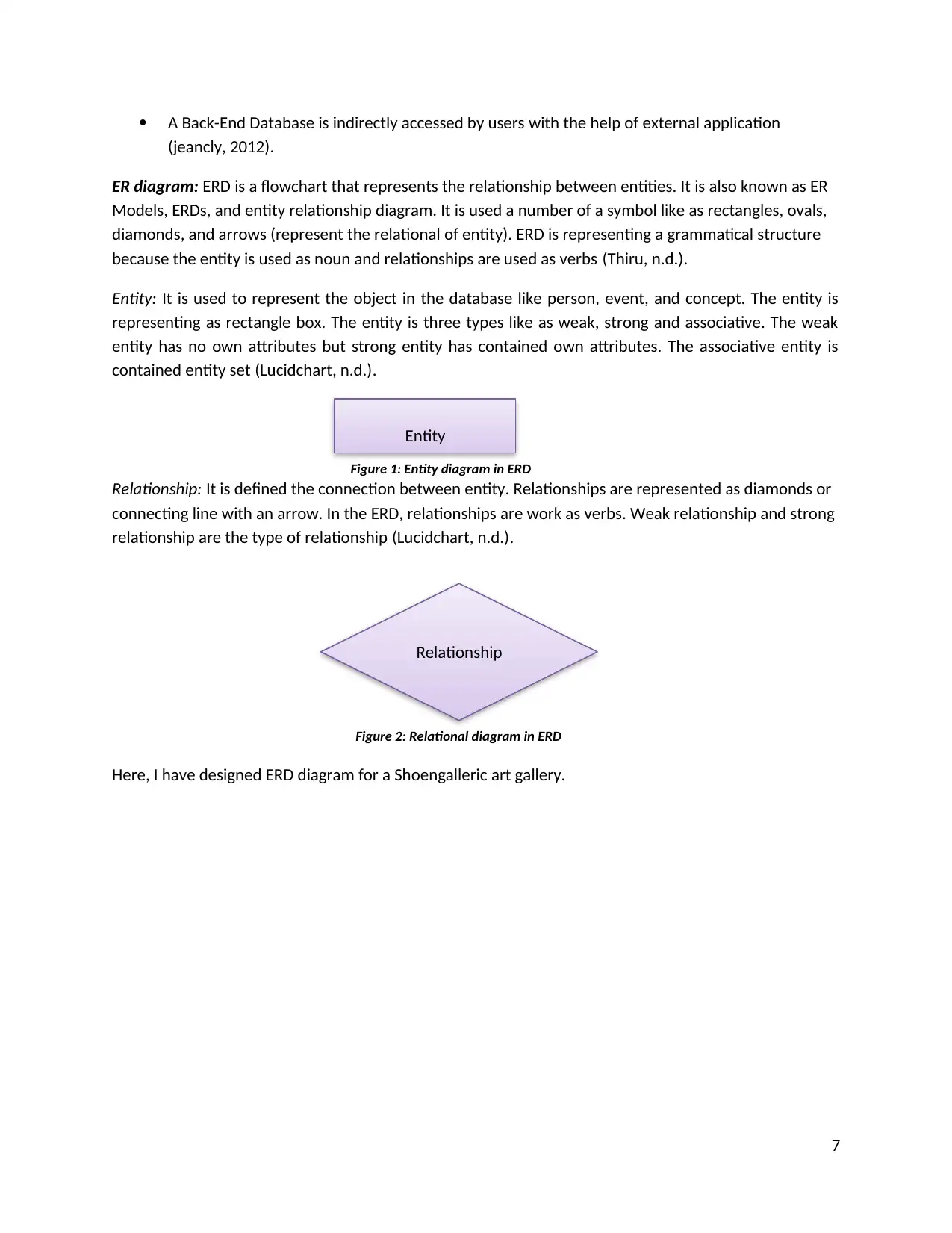
A Back-End Database is indirectly accessed by users with the help of external application
(jeancly, 2012).
ER diagram: ERD is a flowchart that represents the relationship between entities. It is also known as ER
Models, ERDs, and entity relationship diagram. It is used a number of a symbol like as rectangles, ovals,
diamonds, and arrows (represent the relational of entity). ERD is representing a grammatical structure
because the entity is used as noun and relationships are used as verbs (Thiru, n.d.).
Entity: It is used to represent the object in the database like person, event, and concept. The entity is
representing as rectangle box. The entity is three types like as weak, strong and associative. The weak
entity has no own attributes but strong entity has contained own attributes. The associative entity is
contained entity set (Lucidchart, n.d.).
Relationship: It is defined the connection between entity. Relationships are represented as diamonds or
connecting line with an arrow. In the ERD, relationships are work as verbs. Weak relationship and strong
relationship are the type of relationship (Lucidchart, n.d.).
Here, I have designed ERD diagram for a Shoengalleric art gallery.
7
Entity
Relationship
Figure 1: Entity diagram in ERD
Figure 2: Relational diagram in ERD
(jeancly, 2012).
ER diagram: ERD is a flowchart that represents the relationship between entities. It is also known as ER
Models, ERDs, and entity relationship diagram. It is used a number of a symbol like as rectangles, ovals,
diamonds, and arrows (represent the relational of entity). ERD is representing a grammatical structure
because the entity is used as noun and relationships are used as verbs (Thiru, n.d.).
Entity: It is used to represent the object in the database like person, event, and concept. The entity is
representing as rectangle box. The entity is three types like as weak, strong and associative. The weak
entity has no own attributes but strong entity has contained own attributes. The associative entity is
contained entity set (Lucidchart, n.d.).
Relationship: It is defined the connection between entity. Relationships are represented as diamonds or
connecting line with an arrow. In the ERD, relationships are work as verbs. Weak relationship and strong
relationship are the type of relationship (Lucidchart, n.d.).
Here, I have designed ERD diagram for a Shoengalleric art gallery.
7
Entity
Relationship
Figure 1: Entity diagram in ERD
Figure 2: Relational diagram in ERD
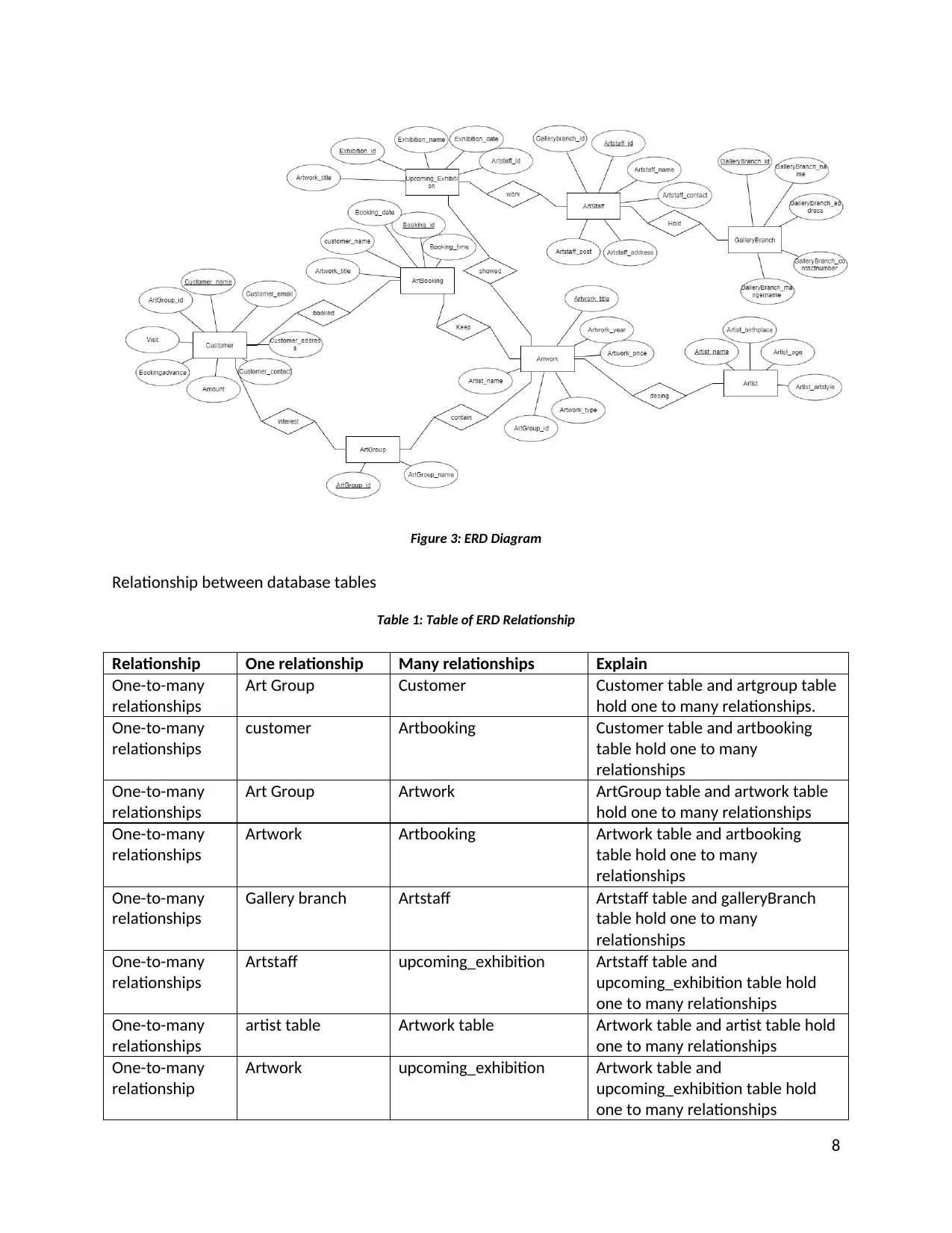
Figure 3: ERD Diagram
Relationship between database tables
Table 1: Table of ERD Relationship
Relationship One relationship Many relationships Explain
One-to-many
relationships
Art Group Customer Customer table and artgroup table
hold one to many relationships.
One-to-many
relationships
customer Artbooking Customer table and artbooking
table hold one to many
relationships
One-to-many
relationships
Art Group Artwork ArtGroup table and artwork table
hold one to many relationships
One-to-many
relationships
Artwork Artbooking Artwork table and artbooking
table hold one to many
relationships
One-to-many
relationships
Gallery branch Artstaff Artstaff table and galleryBranch
table hold one to many
relationships
One-to-many
relationships
Artstaff upcoming_exhibition Artstaff table and
upcoming_exhibition table hold
one to many relationships
One-to-many
relationships
artist table Artwork table Artwork table and artist table hold
one to many relationships
One-to-many
relationship
Artwork upcoming_exhibition Artwork table and
upcoming_exhibition table hold
one to many relationships
8
Relationship between database tables
Table 1: Table of ERD Relationship
Relationship One relationship Many relationships Explain
One-to-many
relationships
Art Group Customer Customer table and artgroup table
hold one to many relationships.
One-to-many
relationships
customer Artbooking Customer table and artbooking
table hold one to many
relationships
One-to-many
relationships
Art Group Artwork ArtGroup table and artwork table
hold one to many relationships
One-to-many
relationships
Artwork Artbooking Artwork table and artbooking
table hold one to many
relationships
One-to-many
relationships
Gallery branch Artstaff Artstaff table and galleryBranch
table hold one to many
relationships
One-to-many
relationships
Artstaff upcoming_exhibition Artstaff table and
upcoming_exhibition table hold
one to many relationships
One-to-many
relationships
artist table Artwork table Artwork table and artist table hold
one to many relationships
One-to-many
relationship
Artwork upcoming_exhibition Artwork table and
upcoming_exhibition table hold
one to many relationships
8
⊘ This is a preview!⊘
Do you want full access?
Subscribe today to unlock all pages.

Trusted by 1+ million students worldwide
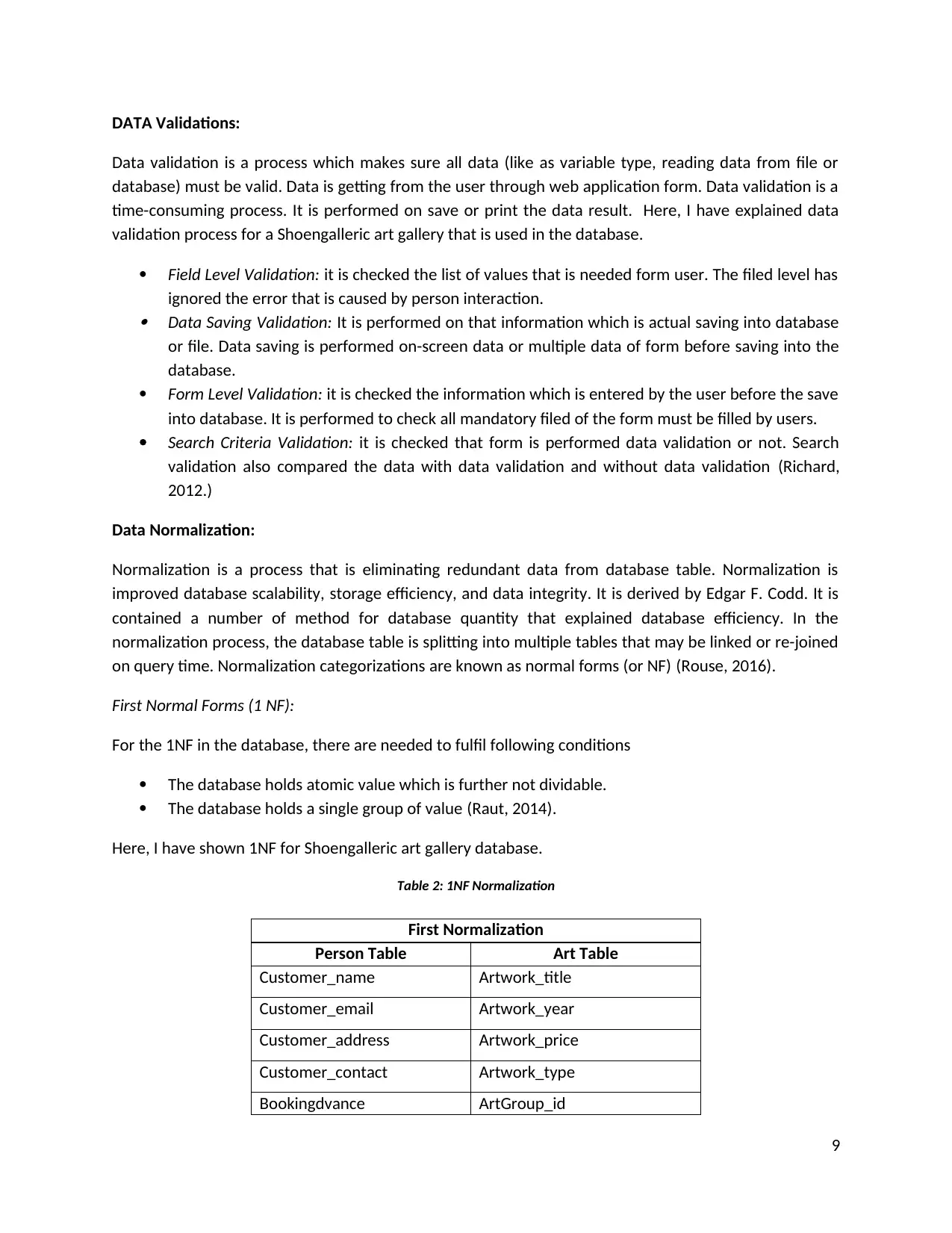
DATA Validations:
Data validation is a process which makes sure all data (like as variable type, reading data from file or
database) must be valid. Data is getting from the user through web application form. Data validation is a
time-consuming process. It is performed on save or print the data result. Here, I have explained data
validation process for a Shoengalleric art gallery that is used in the database.
Field Level Validation: it is checked the list of values that is needed form user. The filed level has
ignored the error that is caused by person interaction.
Data Saving Validation: It is performed on that information which is actual saving into database
or file. Data saving is performed on-screen data or multiple data of form before saving into the
database.
Form Level Validation: it is checked the information which is entered by the user before the save
into database. It is performed to check all mandatory filed of the form must be filled by users.
Search Criteria Validation: it is checked that form is performed data validation or not. Search
validation also compared the data with data validation and without data validation (Richard,
2012.)
Data Normalization:
Normalization is a process that is eliminating redundant data from database table. Normalization is
improved database scalability, storage efficiency, and data integrity. It is derived by Edgar F. Codd. It is
contained a number of method for database quantity that explained database efficiency. In the
normalization process, the database table is splitting into multiple tables that may be linked or re-joined
on query time. Normalization categorizations are known as normal forms (or NF) (Rouse, 2016).
First Normal Forms (1 NF):
For the 1NF in the database, there are needed to fulfil following conditions
The database holds atomic value which is further not dividable.
The database holds a single group of value (Raut, 2014).
Here, I have shown 1NF for Shoengalleric art gallery database.
Table 2: 1NF Normalization
First Normalization
Person Table Art Table
Customer_name Artwork_title
Customer_email Artwork_year
Customer_address Artwork_price
Customer_contact Artwork_type
Bookingdvance ArtGroup_id
9
Data validation is a process which makes sure all data (like as variable type, reading data from file or
database) must be valid. Data is getting from the user through web application form. Data validation is a
time-consuming process. It is performed on save or print the data result. Here, I have explained data
validation process for a Shoengalleric art gallery that is used in the database.
Field Level Validation: it is checked the list of values that is needed form user. The filed level has
ignored the error that is caused by person interaction.
Data Saving Validation: It is performed on that information which is actual saving into database
or file. Data saving is performed on-screen data or multiple data of form before saving into the
database.
Form Level Validation: it is checked the information which is entered by the user before the save
into database. It is performed to check all mandatory filed of the form must be filled by users.
Search Criteria Validation: it is checked that form is performed data validation or not. Search
validation also compared the data with data validation and without data validation (Richard,
2012.)
Data Normalization:
Normalization is a process that is eliminating redundant data from database table. Normalization is
improved database scalability, storage efficiency, and data integrity. It is derived by Edgar F. Codd. It is
contained a number of method for database quantity that explained database efficiency. In the
normalization process, the database table is splitting into multiple tables that may be linked or re-joined
on query time. Normalization categorizations are known as normal forms (or NF) (Rouse, 2016).
First Normal Forms (1 NF):
For the 1NF in the database, there are needed to fulfil following conditions
The database holds atomic value which is further not dividable.
The database holds a single group of value (Raut, 2014).
Here, I have shown 1NF for Shoengalleric art gallery database.
Table 2: 1NF Normalization
First Normalization
Person Table Art Table
Customer_name Artwork_title
Customer_email Artwork_year
Customer_address Artwork_price
Customer_contact Artwork_type
Bookingdvance ArtGroup_id
9
Paraphrase This Document
Need a fresh take? Get an instant paraphrase of this document with our AI Paraphraser
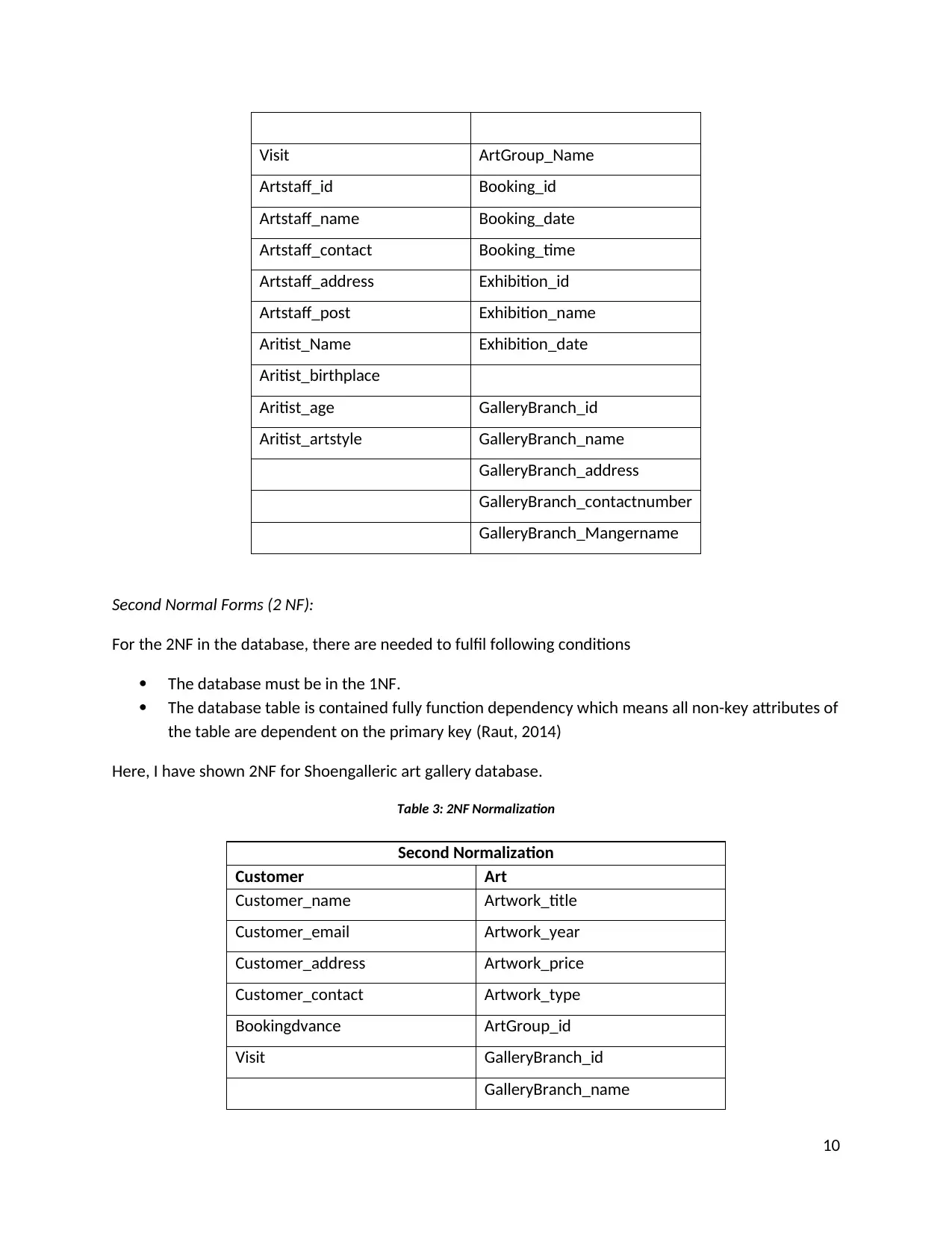
Visit ArtGroup_Name
Artstaff_id Booking_id
Artstaff_name Booking_date
Artstaff_contact Booking_time
Artstaff_address Exhibition_id
Artstaff_post Exhibition_name
Aritist_Name Exhibition_date
Aritist_birthplace
Aritist_age GalleryBranch_id
Aritist_artstyle GalleryBranch_name
GalleryBranch_address
GalleryBranch_contactnumber
GalleryBranch_Mangername
Second Normal Forms (2 NF):
For the 2NF in the database, there are needed to fulfil following conditions
The database must be in the 1NF.
The database table is contained fully function dependency which means all non-key attributes of
the table are dependent on the primary key (Raut, 2014)
Here, I have shown 2NF for Shoengalleric art gallery database.
Table 3: 2NF Normalization
Second Normalization
Customer Art
Customer_name Artwork_title
Customer_email Artwork_year
Customer_address Artwork_price
Customer_contact Artwork_type
Bookingdvance ArtGroup_id
Visit GalleryBranch_id
GalleryBranch_name
10
Artstaff_id Booking_id
Artstaff_name Booking_date
Artstaff_contact Booking_time
Artstaff_address Exhibition_id
Artstaff_post Exhibition_name
Aritist_Name Exhibition_date
Aritist_birthplace
Aritist_age GalleryBranch_id
Aritist_artstyle GalleryBranch_name
GalleryBranch_address
GalleryBranch_contactnumber
GalleryBranch_Mangername
Second Normal Forms (2 NF):
For the 2NF in the database, there are needed to fulfil following conditions
The database must be in the 1NF.
The database table is contained fully function dependency which means all non-key attributes of
the table are dependent on the primary key (Raut, 2014)
Here, I have shown 2NF for Shoengalleric art gallery database.
Table 3: 2NF Normalization
Second Normalization
Customer Art
Customer_name Artwork_title
Customer_email Artwork_year
Customer_address Artwork_price
Customer_contact Artwork_type
Bookingdvance ArtGroup_id
Visit GalleryBranch_id
GalleryBranch_name
10
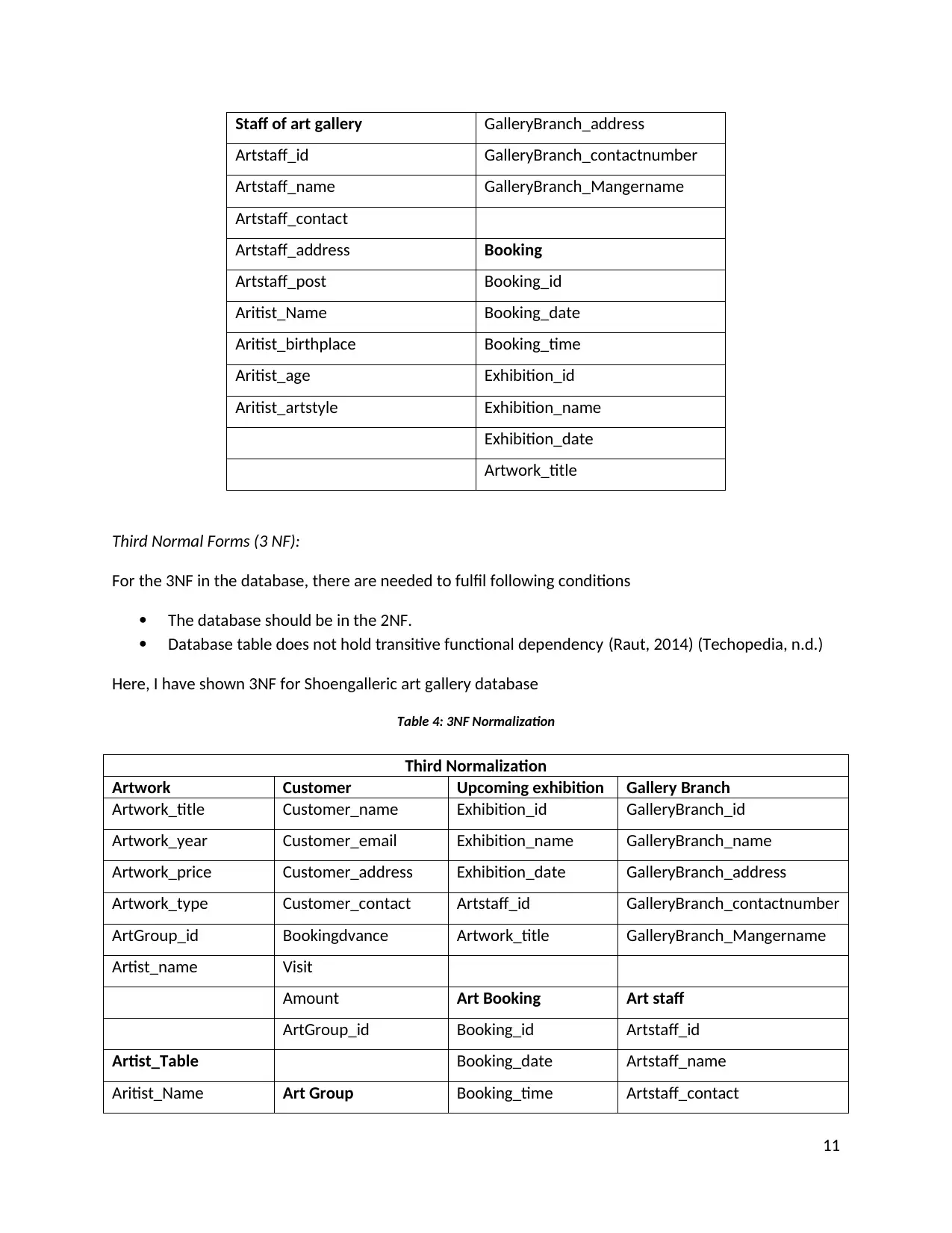
Staff of art gallery GalleryBranch_address
Artstaff_id GalleryBranch_contactnumber
Artstaff_name GalleryBranch_Mangername
Artstaff_contact
Artstaff_address Booking
Artstaff_post Booking_id
Aritist_Name Booking_date
Aritist_birthplace Booking_time
Aritist_age Exhibition_id
Aritist_artstyle Exhibition_name
Exhibition_date
Artwork_title
Third Normal Forms (3 NF):
For the 3NF in the database, there are needed to fulfil following conditions
The database should be in the 2NF.
Database table does not hold transitive functional dependency (Raut, 2014) (Techopedia, n.d.)
Here, I have shown 3NF for Shoengalleric art gallery database
Table 4: 3NF Normalization
Third Normalization
Artwork Customer Upcoming exhibition Gallery Branch
Artwork_title Customer_name Exhibition_id GalleryBranch_id
Artwork_year Customer_email Exhibition_name GalleryBranch_name
Artwork_price Customer_address Exhibition_date GalleryBranch_address
Artwork_type Customer_contact Artstaff_id GalleryBranch_contactnumber
ArtGroup_id Bookingdvance Artwork_title GalleryBranch_Mangername
Artist_name Visit
Amount Art Booking Art staff
ArtGroup_id Booking_id Artstaff_id
Artist_Table Booking_date Artstaff_name
Aritist_Name Art Group Booking_time Artstaff_contact
11
Artstaff_id GalleryBranch_contactnumber
Artstaff_name GalleryBranch_Mangername
Artstaff_contact
Artstaff_address Booking
Artstaff_post Booking_id
Aritist_Name Booking_date
Aritist_birthplace Booking_time
Aritist_age Exhibition_id
Aritist_artstyle Exhibition_name
Exhibition_date
Artwork_title
Third Normal Forms (3 NF):
For the 3NF in the database, there are needed to fulfil following conditions
The database should be in the 2NF.
Database table does not hold transitive functional dependency (Raut, 2014) (Techopedia, n.d.)
Here, I have shown 3NF for Shoengalleric art gallery database
Table 4: 3NF Normalization
Third Normalization
Artwork Customer Upcoming exhibition Gallery Branch
Artwork_title Customer_name Exhibition_id GalleryBranch_id
Artwork_year Customer_email Exhibition_name GalleryBranch_name
Artwork_price Customer_address Exhibition_date GalleryBranch_address
Artwork_type Customer_contact Artstaff_id GalleryBranch_contactnumber
ArtGroup_id Bookingdvance Artwork_title GalleryBranch_Mangername
Artist_name Visit
Amount Art Booking Art staff
ArtGroup_id Booking_id Artstaff_id
Artist_Table Booking_date Artstaff_name
Aritist_Name Art Group Booking_time Artstaff_contact
11
⊘ This is a preview!⊘
Do you want full access?
Subscribe today to unlock all pages.

Trusted by 1+ million students worldwide
1 out of 49
Related Documents
Your All-in-One AI-Powered Toolkit for Academic Success.
+13062052269
info@desklib.com
Available 24*7 on WhatsApp / Email
![[object Object]](/_next/static/media/star-bottom.7253800d.svg)
Unlock your academic potential
Copyright © 2020–2025 A2Z Services. All Rights Reserved. Developed and managed by ZUCOL.





